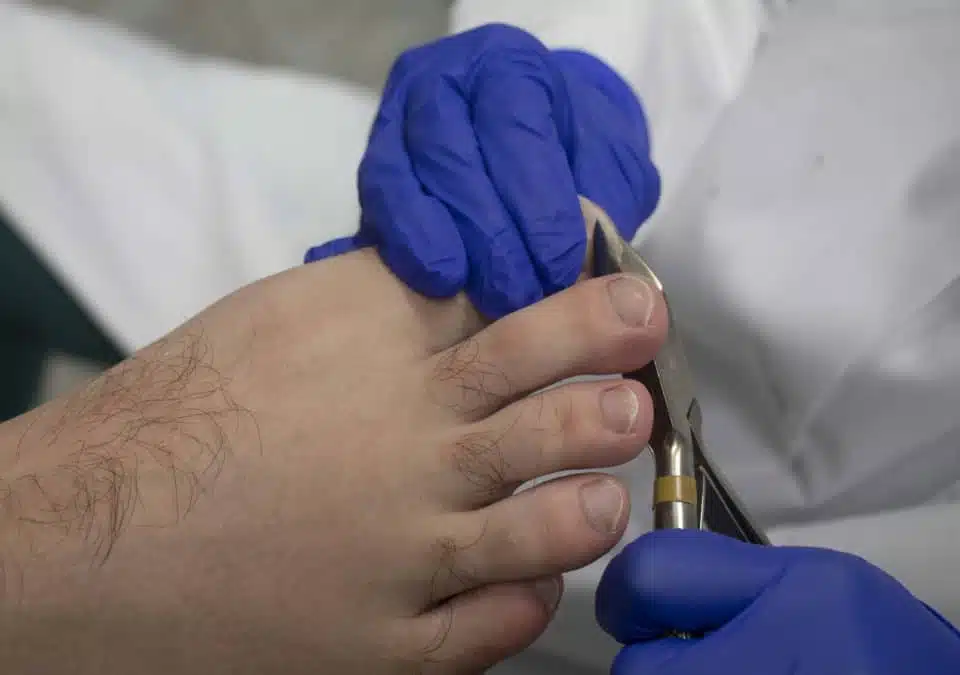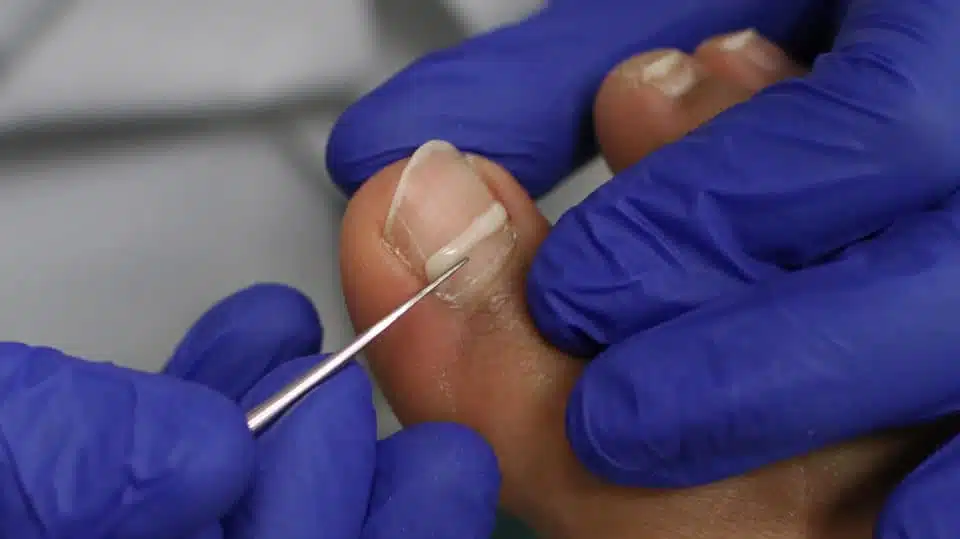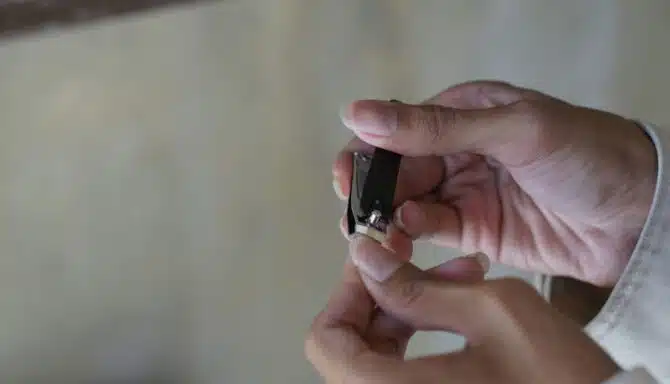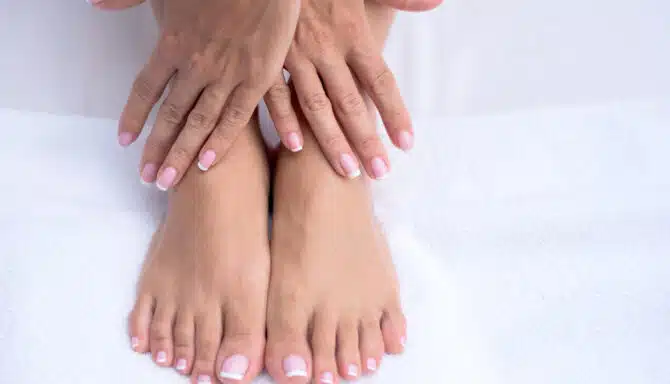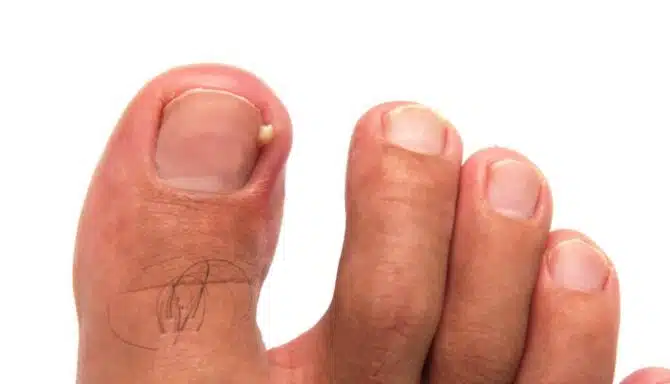July 11, 2024
There's always the right tool for the job. Using each tool for its intended purpose is best, or you risk doing more damage than good. That's why fingernail clippers and toenail clippers exist.
To understand why, it's important to understand the difference between toenails and fingernails. Toenails are thicker, harder, and grow slower than fingernails because your feet and hands serve different functions. Toenails also have a greater surface area.
In this blog post, we explain why you should avoid using fingernail clippers for your toenails and opt for toenail clippers exclusively.
Reduce the risk of bacterial or fungal contamination
For one, separating your nail tools prevents contamination and possible spread of bacteria and fungus. Given how exposed your hands are every day, you wouldn't want to spread any bacteria to your feet.
When in doubt, clean your clippers with 70%—90% isopropyl alcohol.
Fingernail clippers may not work on toenails
When looking at fingernail vs. toenail clippers, the size difference is stark. Fingernail clippers are smaller, narrower, and curved. Toenail clippers are larger, wider, and straight across, as you should trim your toenails straight across. Cutting them with a curved edge increases your risk of ingrown toenails.
If you want more guidance on choosing the tool for your toenails, read our blog post on our top choices for toenail clippers.
Limit the risk of cracking and damaging your toenails
Using sharp, rigid toenail clippers makes trimming easy and more effective. Using fingernail clippers means you'll need to apply more pressure to cut the nail and risk damaging or even cracking the toenail.
If you don’t have the right tools, enough time, or simply the confidence to focus on a nail trim, try a medical pedicure instead. It includes the right nail trimming procedure and includes moisturization, thorough cleaning, and more. Before the nail trim, a chiropodist also examines your feet for other foot conditions.
Prevent ingrown toenails
You'll also notice the curvature of fingernail vs. toenail clippers. Fingernail clippers are curved and meant to follow the contours of your fingernails. On the other hand, toenails are plateaued and should be cut straight across. Using a curved tool on your toenails puts you at risk of jagged edges, nail splitting, or could be a root cause of ingrown toenails.
If you wish, use a nail file to round the edges. This tool is necessary for properly smoothing the edges of the nails. After the trimming, there will likely be some jagged edges, sharp corners, and “spikes.”
March 18, 2024
Toenail care is your shield from future foot issues. Foot conditions affecting the toenails can lead to infections, fungus, brittle and damaged nails, pain, bleeding and more. But you have the power to prevent these complications! By investing in proper footwear, learning to trim your nails properly, and more, you can take the reins on your toenail health.
Let's talk toenails!
Preventing Fungal Infections and Other Toenail Conditions
Practice Proper Toenail Trimming
It would be nice to have a professional always trim our nails for us, but sometimes we do have to do toenail care ourselves. To prevent issues or conditions, trim your nails following these two simple steps:
Use nail clippers to trim straight across (very important), avoiding curved edges.
Smooth edges with a nail file if needed.
Keep Your Feet Clean and Protected
Fungal toenails love when you forget to care for your feet.
Make sure you always thoroughly clean and dry your feet before wearing socks and shoes. To go the extra mile and protect from skin issues, moisturize, exfoliate and use a foot file.
Avoid areas where contagious fungal viruses breed and are passed along. These include public pool grounds, public showers, shared locker rooms, and more. If you frequent places like this, always wear shoes.
Pedicure safety and hygiene are also very important when it comes to prevention. Schedule medical pedicure appointments with your chiropodist instead of a cosmetic pedicure to avoid contracting a contagious fungal infection and for a more health-focused experience. Learn more about the difference between a cosmetic and medical pedicure.
Make Healthy Footwear Choices
The link connecting toenail issues and footwear may seem unclear, but picture it this way:
When our shoes are too tight it often means there is not enough room for the toes to spread out naturally. This can wreak havoc on your nails and you also risk annoying ingrown toenails or a cracked toenail. Always buy shoes with enough room in the toe box!
Take it to the next level by looking for running shoes with mesh uppers that allow air to flow inside the shoe. This is a bonus way of keeping your toes fresh and protecting against fungal infections. Check out this handy shoe shopping checklist for even more help!
Toenail Care for Pre-existing Conditions
Anti-fungal Treatments for Toenails
You won’t be able to treat a current fungal infection without using antifungal products or visiting a chiropodist. Products include sprays, ointments and sometimes pills. At times, over-the-counter versions like ClearNails Pro + (available at Feet First Clinic) are enough, but other times, you’ll need a prescription for a persistent infection. Chiropodists can also perform nail debridement, which involves removing the infected part of the nail and thinning the outer layers of the toenail. This allows prescription-strength topical antifungal medication to penetrate the toenail and reach the fungus.
Treating Cracked Toenails
Cracked toenails are more of a nuisance than a serious problem. But messing with your toenails in any way can still cause bleeding and pain. You may be more susceptible to cracks if your nails are weak and brittle.
If you’re looking for some ways to speed up nail growth, but also to strengthen your nails as they are, try these toenail growth tips:
As we've mentioned, trim nails straight across and avoid trimming too close to the skin
Again, wear well-fitting shoes. Tight shoes can disrupt healthy toenail growth.
Protect toenails during physical activities.
Avoid excessive use of nail polish. While polish itself doesn’t slow growth, some types can cause toenail dehydration, making your nails more likely to crack.
Eat a balanced diet for nail health.
Treating Ingrown Toenails
OnyFix is a useful and modern way of treating ingrown toenails. It involves the application of a specialized corrective strip to the affected nail. Nail avulsions can also be a good idea for chronic, severe ingrown nails, and chiropodists may tackle infections using certain draining methods.
Treating Toenail Discolouration
Discoloured toenails are tricky because the colours can vary wildly. Discolouration caused by a fungal infection (green or yellow) may be treated using similar methods as fungal toenails. But if your discolouration is black, blue, purple, or red, this is probably linked to a mild blunt-force trauma injury (like dropping something on your toe). It’s best to schedule a nail care appointment to determine the culprit!
January 15, 2024
At some point, we've all experienced the discomfort of a pesky ingrown toenail. It occurs when the nail plate grows into the surrounding skin and causes inflammation. Ingrown toenails are among the most common toenail conditions and are particularly common in the big toe.
Whether it's a result of a stubbed toe, improper nail-trimming habits, or the perils of snug footwear, ingrown toenails can quickly turn into a painful ordeal. In this article, we'll delve into the causes behind these troublesome toenail invaders, explore effective home remedies to ease the discomfort, and discuss when to seek professional help for a more permanent solution.
Causes of Ingrown Toenails
Improper nail trimming
Cutting toenails too short or rounding the edges can encourage the nail to grow into the skin. The skin surrounding the nail should not be higher than the toenail as this may cause the nail to grow into the skin instead of on top of it. Instead, cut the nail to the skin's edge and not any deeper.
Ill-fitting shoes
Tight or narrow shoes can pressure the toes, causing the nails to grow abnormally.
Injury or trauma
Stubbing your toe or other injuries can lead to ingrown toenails.
Genetics
Some people may have a genetic predisposition to ingrown toenails.
Poor foot hygiene
Not keeping the feet clean and dry can affect the skin around the nail bed, and contribute to the development of ingrown toenails.
At-home remedies for Ingrown Toenails
At-home remedies are an option while you wait for professional treatment. Note: Never attempt to cut the ingrown toenail yourself.
Warm soaks
Soak the affected foot in warm water for 15-20 minutes daily to reduce inflammation.
Cotton ball or dental floss
Gently lift the ingrown edge of the nail and place a small piece of cotton or dental floss underneath to encourage the nail to grow above the skin.
Antibiotic ointment
Apply an antibiotic ointment to prevent infection.
Wear proper footwear
Choose shoes with enough room for your toes, and avoid tight-fitting footwear.
Avoid aggravating activities
If possible, avoid activities that put extra pressure on the toes.
Professional treatment remedies for Ingrown Toenails
At-home treatment is only so effective. When in doubt, it's best to consult a professional for proper care and treatment. A chiropodist or foot specialist may perform any number of the following professional treatments:
Proper toenail care and trimming
Cutting toenails too short or at the wrong angle can cause ingrown toenails. A chiropodist can properly trim and cut your toenails in a way that promotes proper nail growth. They can trim to treat an existing ingrown toenail, or trim your toenails preventatively, for example, during a medical procedure or nail care appointment.
A chiropodist can also soften the skin, lift the edge of the nail from the skin, and then prop the corner of the nail over the skin edge until the skin heals. Finally, as it relates to toenail care, a specialist may apply a freezing gel or a Lidocaine to remove the ingrown portion of the toenail.
Onyfix
Onyfix is a special composite material that the chiropodist applies it in a band across the nail. It acts like a nail brace to correct the nail's growth.
Partial nail avulsion (PNA)
A local anesthetic first numbs the toe. A narrow vertical strip is then removed from the edge of the affected side of the nail down the entire length. Antibiotics and a dressing are applied to the exposed nail bed to prevent infection. This surgical procedure is performed if other treatment options do not work.
Total nail avulsion (TNA)
Total nail avulsion is similar to a partial nail avulsion, except the whole nail is removed. This surgical procedure is performed if other more conservative approaches are insufficient.
Phenol
This chemical is applied to the nail's root beneath the cuticle to prevent regrowth. It may be used during a PNA or TNA to prevent nail regrowth.
When to seek professional help for Ingrown Toenails
It can be challenging to differentiate what's serious versus not. Sometimes, minor ingrown toenails can be treated at home in their early stages. Other times, you should seek professional help. Here are a few scenarios that should have you consider seeking professional help:
Any signs of infection
If there is increased redness, swelling, or drainage of pus, it may indicate an infection that requires medical attention.
Moderate to severe pain
Seek professional help if the toenail pierces the skin or if you experience moderate to severe pain.
Persistent ingrown toenails
If ingrown toenails are a recurring problem, seeing a chiropodist for a more permanent solution may be necessary.
Underlying medical conditions
Individuals with diabetes or circulatory disorders should seek professional care for ingrown toenails at any stage.
It's essential to address ingrown toenails promptly to prevent complications. If you're unsure how to treat an ingrown toenail or suspect an infection, it's advisable to consult with a healthcare professional or podiatrist for proper diagnosis and treatment.
November 2, 2023
As the leaves begin to fall and the air grows crisp, many of us look forward to the cozy comforts of autumn: sweaters, changing colours, and pumpkin spice. However, with the arrival of fall comes a less welcoming guest: dry feet. The air dries as temperatures drop, leading to dry, cracked skin, itchiness and other foot-related issues.
This guide explores common causes of dry feet during the fall and offers practical tips and remedies to help you maintain soft, healthy feet as you navigate the season's challenges. Whether preparing for brisk walks through fallen leaves or cozy evenings by the fireplace, taking care of your feet is a crucial component of embracing the beauty of autumn without the discomfort of dry skin. Here are some tips to help you maintain proper foot care during the fall and winter months:
1. Stay hydrated
While we often focus on external solutions, it's essential to remember that healthy skin starts from within. Staying well-hydrated is the foundation of soft, supple skin, including your feet. When your body is adequately hydrated, it helps your skin maintain its natural moisture balance. So, sip on those warm beverages synonymous with the season, and remember to drink plenty of water throughout the day.
2. Use rich foot creams
Autumn is the perfect time to upgrade your skincare routine, and your feet deserve special attention. Invest in a high-quality foot cream with nourishing ingredients like urea, shea butter, cocoa butter, or hyaluronic acid. Apply your cream daily to lock in moisture and protect your feet from the drying effects of the season.
3. Regularly exfoliate
As the weather transitions, your skin may accumulate dead cells, making it harder for moisturizers to penetrate. To overcome this, indulge in a gentle exfoliation routine. Use a foot scrub or a pumice stone to remove dead skin, but be cautious not to overdo it – gentle is better. A medical pedicure can also help revive your dry skin in the fall, as the chiropodist will safely remove any dry, dead skin and then apply a medical-grade moisturizer during your treatment.
4. Soak your feet
What could be cozier than a warm foot soak on a chilly evening? Soaking your feet in warm water relaxes you and helps rehydrate your skin. Enhance the experience by adding a lavender or tea tree for extra relaxation and antimicrobial benefits.
5. Pick the proper footwear
Footwear plays a significant role in maintaining foot health. When heading out into the cool fall weather, opt for insulated, water-resistant footwear that protects your feet from moisture and potential frostbite. Ensure your shoes are also the right size to avoid constriction and discomfort, a common cause of dry, cracked skin.
6. Practice proper nail care
Pay attention to your toenails. Trim them straight across, not too short, to prevent ingrown toenails. A good-quality nail clipper can make this task a breeze.
7. Ask a professional
If you're dealing with severe dryness, deep cracks, or persistent foot problems, it's wise to seek advice from a foot specialist, like a chiropodist. They can offer personalized solutions and treatments tailored to your specific needs.
8. Keep moving
Exercise is not only good for your overall health but also for your feet. Regular physical activity improves circulation, which, in turn, benefits your feet. However, make sure to choose appropriate footwear for your chosen activities.
9. Welcome and embrace indoor comforts
Slip into soft, cushioned slippers to shield your feet from the cold, hard floors at home. It's a small change that can make a big difference.
10. Control your environment indoors
If your home has central heating, use a humidifier to add moisture to the air. Centralized heating systems can dry out the air, which, in turn, can contribute to dry skin.
By incorporating these ten practices into your autumn routine, you can prevent dry feet and embrace the season's delights with the comfort and confidence of healthy, moisturized skin.
January 16, 2023
Fact: Your toenails can give you clues about your overall health. That's right, the state of your nails, including toenails, can indicate an underlying health condition. Conversely, healthy nails can be a sign of a healthy lifestyle.
The state of our toenails can differ in a lot of ways. Toenails can splinter, thicken, thin, peel, dry out, break, and pit. Toenail pitting is the focus of this article.
Below, you'll learn about toenail anatomy, the basics of pitting, signs, treatment methods, and preventative measures to keep your nails in good shape.
Toenail anatomy
Before we delve into the details of toenails and pitting, we must understand their anatomy and the part it plays for our feet.
Toenails are the plate-like covers on our toes. Alpha-keratin, a type of protein, comprises toenails. Alpha-keratin is the same protein building block for hair and the outermost layer of our skin (the epidermis). Generally, the toenail is about 0.5 mm thick and slightly curved.
The toenail consists of several distinct components. The toenail includes the nail plate, the cuticle, and the nail folds surrounding the nail's perimeter. The part referred to as the toenail colloquially is the "nail plate."
What's toenail pitting?
Pitting, by definition, is an indentation. Toenail pitting follows the same logic. Pitting of the nail occurs when tiny dents or "pits" form in the nail plate. Toenail pitting is a type of nail abnormality.
Toenail indents can be shallow and only recognizable by touch. Deep toenail pits may be visible due to their concave nature. Within the grooves, some parts of the pitting may be deeper than others, just as there are deeper and shallow parts of a pit.
Nail pitting is generally more common for fingernails, but toenails are also affected.
What causes toenail pitting?
There are several causes for toenail pitting. Toenail pitting reasons range from external trauma to an underlying medical condition. Learn about the various causes of toenail pitting below.
Nail psoriasis
Psoriasis is a chronic inflammatory disease that can cause toenail pitting. Those with nail psoriasis produce too many skin cells, causing nail irregularities. According to Healthline.com, approximately 80% of those with psoriatic arthritis experience nail irregularities or changes.
You may be able to recognize nail psoriasis because of two related symptoms: discolouration and nail bed separation. There are a few groups more likely to develop nail psoriasis. At-risk factors include:
People who are over 40 (though psoriasis may occur at any age)
Males
Genetics
Psoriatic arthritis
According to a study published in the National Library of Medicine, psoriasis can cause toenail pits "remarkably even in size and depth. Their distribution may be haphazard or sometimes arranged in parallel transverse or short longitudinal lines."
Though psoriasis is not curable, you can mask the effects of toenail pitting. You can buff or apply nail polish to hide the indents and improve the aesthetic.
Nail eczema
Eczema is a condition that causes itchy and red skin. The disease can cause nail thickening or pitting when eczema targets the feet.
Habit-tic deformity
Habit-tic deformity on the fingernail.
The habit-tic deformity is a nail condition similar to toenail pitting with several differences. When you constantly pick at your nails, external trauma can create pits in your nail. The habit-tic deformity is most common on the fingernails, specifically the thumbs, but it can also happen on your toenails. For instance, if you sit cross-legged or have your feet at arm's reach, you may develop a habit of picking at your toenails.
The defining features of habit-tic deformity are horizontal ridges across the nail and a slight depression in the middle of the nail plate. The habit-tic deformity is not severe and typically heals if left alone. The condition is known as "washboard nails" because of the horizontal nail ridges.
Reiter's syndrome/reactive arthritis
Those with reactive arthritis may experience toenail pitting. An infection or bacterial infection elsewhere in the body can cause reactive arthritis, also known as Reiter's syndrome. People with a specific type of gene are more likely to develop the condition, as it's believed to be genetic.
How do you fix nail pitting?
Toenail pitting fixes vary. In some cases, like psoriasis, there is no cure. Cosmetic procedures are an option to mask the effects. Removing external trauma can help reverse toenail pitting in cases like a habit-tic deformity.
Additional treatment options include medication applied to the nail itself. Options include steroids, salicylic acid, calcipotriol, cyanoacrylate adhesive (for the habit-tic deformity) and tazarotene.
Is nail pitting serious?
In most cases, nail pitting as a symptom isn't severe. Nail pitting is more often a cosmetic issue than a medical issue. However, the underlying conditions that cause toenail pitting can vary in severity.
January 9, 2023
There can be a range of discolouration in your toes and the most common is a pinkish/red hue, or red toes. Red toe onset may be immediate or progressive. The redness often resolves itself, but it may sometimes present symptoms of underlying problems. Learn more about red toes and potential risks in our article below!
Why Are My Toes Red And Itchy?
Red toes result from inflammation, injury, temperature, skin irritation, and infection. Varying degrees of redness may indicate the severity of damage to the toes. In some cases, redness may subside independently, while others may require medical attention.
What Medical Conditions Cause Red Toes?
Red toe causes range from skin conditions, to musculoskeletal damage, to infection. Below, we've categorized medical conditions that cause red toes by severity. Note that all medical conditions can have varying degrees of severity, so use this list as a reference, not a diagnosis.
Lower Severity
Blisters
A blister is a small fluid-filled bubble that forms just under the outer layer of the skin. The fluid (usually a serum, rarely blood) is a natural cushion to protect the tissue underneath from friction and irritation. Fortunately, blisters often heal on their own once the source of friction is eliminated. As tempting as it may be, avoid popping the blister and allow it to heal naturally.
Frostnip
Frostnip is a mild, non-severe cold injury to the skin and tissue. As such, frostnip doesn't cause permanent damage. You can treat frostnip with basic first aid. Above all else, you should try to escape the cold as quickly as possible. Possible complications include infection and temporary nerve damage, which are rare if caught at the frostnip stage.
Stubbed Toe
A stubbed toe occurs any time you jam your toe against another object and is technically a trauma injury. The injury results from a one-time accident. Depending on the severity, damage to the toe may cause swelling and inflammation, muscle injury, and even bone fractures.
Contact Dermatitis
Contact dermatitis is a red, itchy rash triggered by an allergic reaction. The skin's response to an irritant causes inflammation, followed by a rash. Contact dermatitis isn't contagious nor life-threatening, but it can be very uncomfortable. Soaps, plants, detergents, or jewelry have the potential to cause an allergic reaction.
One can treat and prevent contact dermatitis by identifying and removing environmental allergens. A doctor can also prescribe topical medications to help treat flare-ups.
Athlete's Foot
Fungal skin infections like athlete's foot are a common culprit of red toes. The toe fungus is not life-threatening, but it is contagious and may spread elsewhere on your body or even to other people. It can also cause foot pain and difficulty walking if left untreated.
Nail Infection
Paronychia is an infection of your nail folds typically caused by bacteria or a fungus and can cause toe pain and swelling, which causes redness and the appearance of red toes.
Ingrown Toenail
An ingrown toenail is a nail condition that targets the toes, mainly the big toe. As the name implies, it occurs when the sides or edges of the toenail grow into the skin and can cause bleeding, redness and pain. If left untreated, the ingrown toenail can get infected.
Moderate Severity
Gout
Gout is a form of inflammatory arthritis caused by heightened uric acid in the blood. The most common joint it affects is the joint that connects your big toe to the rest of the foot. If left untreated, gout attacks may reoccur, increase in severity and lead to enduring joint damage.
Frostbite (superficial)
Superficial frostbite is a stage more severe than frostnip. Cold temperatures damage the skin and the underlying tissues in your toes. Blisters form 24-36 hours after rewarming, and you may experience pain and discomfort for several days.
Higher Severity
Rheumatoid Arthritis
Rheumatoid arthritis ("RA") is an auto-immune disease that causes chronic joint inflammation. RA causes periodic flare-ups of joint pain, stiffness and swelling, eventually making movement difficult. Although there is no cure, you can manage the condition with proactive and diligent treatment focusing on your overall health and well-being.
Diabetes
People with diabetes may experience two conditions that cause red toes: peripheral vascular disease and nerve damage (diabetic neuropathy). Nerve damage and reduced circulation can cause an itchy or numbing pain in the toes. Diabetes can also hinder the body's ability to fight less severe conditions due to reduced immune response and blood circulation.
Frostbite (deep)
Deep frostbite is the most severe form of cold damage to the skin. Your skin or tissue may turn red or even black. You may sometimes lose muscle function and require surgery to remove part of the toe.
Bunions
A bunion is a foot condition of the first metatarsophalangeal joint. The damage to the joint causes pain and redness, and the increased volume of your toes can make wearing shoes uncomfortable. Without proper footwear or orthotics, you can further aggravate your bunions.
Bunions are irreversible and have no "cure" other than surgery. However, physical therapy and accommodations, like orthotics and proper footwear, improve quality of life.
How Can I Prevent My Toes From Turning Red?
We've created a treatment guideline below:
Low severity. Low-grade medical or skin red toe conditions are treatable, often at home. Treatment methods include topical creams or prescription medication, rest, recovery, taping, or changing footwear. Further prevention should focus on recognizing signs and symptoms of red toes early and following proper foot hygiene.
Moderate severity. Moderate severity medical or skin red toe conditions are a mix of prevention and treatment. A proper diagnosis is often required, followed by a treatment plan. Rest and recovery may be part of the treatment plan, but the recovery may be longer (weeks, not days). Like low-severity causes, prevention should focus on recognizing signs and symptoms of red toes early and following proper foot hygiene.
Higher severity. For more severe red toe conditions, the focus is more geared towards improving quality of life and implementing tools to improve mobility, like custom foot orthotics or orthopedic footwear.
